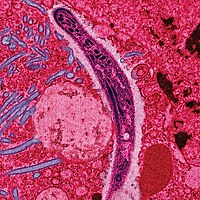
Photo from wikipedia
COVID-19-associated pulmonary aspergillosis (CAPA) has had a high incidence. In addition, it has been associated with prolonged hospital stays, as well as several predisposing risk factors, such as fungal factors… Click to show full abstract
COVID-19-associated pulmonary aspergillosis (CAPA) has had a high incidence. In addition, it has been associated with prolonged hospital stays, as well as several predisposing risk factors, such as fungal factors (nosocomial organism, the size of the conidia, and the ability of the Aspergillus spp. of colonizing the respiratory tract), environmental factors (remodeling in hospitals, use of air conditioning and negative pressure in intensive care units), comorbidities, and immunosuppressive therapies. In addition to these factors, SARS-CoV-2 per se is associated with significant dysfunction of the patient’s immune system, involving both innate and acquired immunity, with reduced CD4+ and CD8+ T cell counts and cytokine storm. Therefore, this review aims to identify the factors influencing the fungus so that coinfection with SARS-CoV-2 can occur. In addition, we analyze the predisposing factors in the fungus, host, and the immune response alteration due to the pathogenicity of SARS-CoV-2 that causes the development of CAPA.
Journal Title: Pathogens
Year Published: 2022
Link to full text (if available)
Share on Social Media: Sign Up to like & get
recommendations!